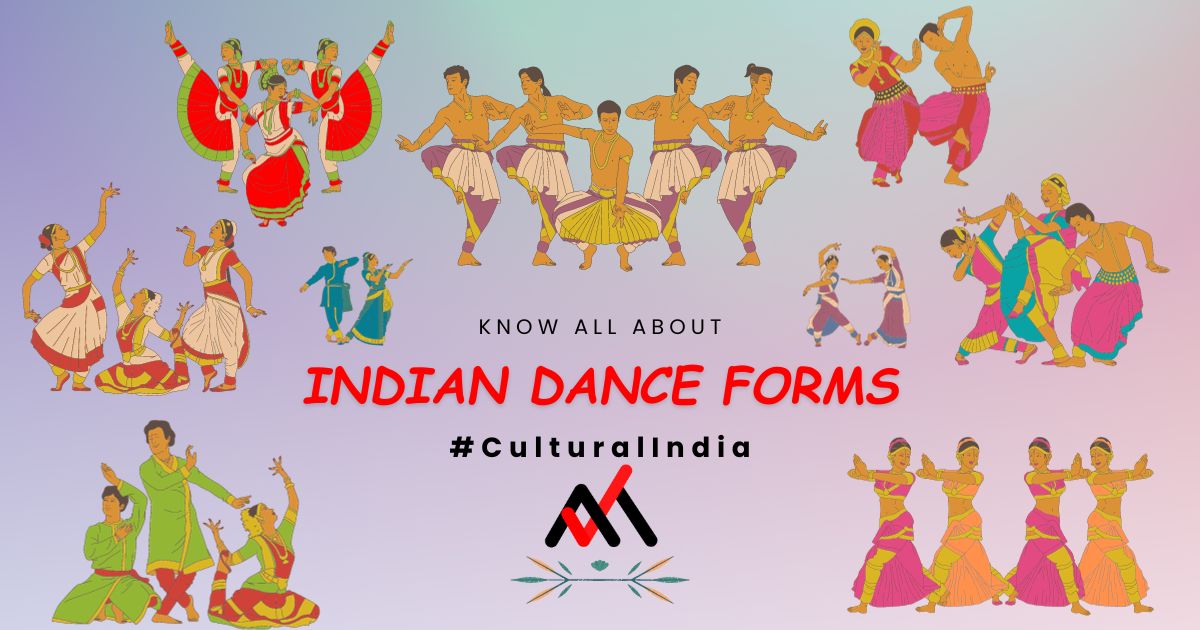India, a land steeped in tradition and culture, has a rich tapestry of performing arts that have thrived for centuries. From the ancient courtrooms of Lord Indra to modern-day stages, Indian dances have evolved, inspired, and captivated generations. Let’s take a closer look at some of the mesmerizing dance forms that have etched their mark on the canvas of Indian culture.
Page Index
Nurturing the Essence of Dance
The roots of Indian dance can be traced back to antiquity. Wall paintings, excavated artifacts, and historical accounts vividly depict various dance forms that have graced the subcontinent for millennia.
The Natyashastra, a seminal text on performing arts, meticulously categorizes these art forms into three distinct categories: Nritta (pure dance with no expressions), Nritya (a blend of dance and expression), and Natya (a combination of dialogue, music, and dance).
Classical and Folk: The Dance Divide
Indian dance forms are primarily categorized into two broad categories: Classical and Folk. Irrespective of the category, most dance forms have deep-rooted connections to religion and spirituality.
Bharatanatyam
One of the oldest classical dance forms, Bharatanatyam, originates from Tamil Nadu. It has evolved from a dance form to a theatrical art, narrating tales of love and devotion. The 19th-century ‘Tanjore Quartet’ significantly contributed to the contemporary rendition of Bharatanatyam.
Kathak
Kathak, a popular dance form in northern India, including Uttar Pradesh, Madhya Pradesh, and Rajasthan, draws inspiration from epic tales like the Ramayana and Mahabharata. It is known for its elegant footwork and graceful pirouettes.
Odissi
Originating in the temples of Odisha, Odissi was initially performed by ‘maharis.’ The divine love story of Radha and Krishna and themes from Vaishnava traditions accentuate this art. Its soft and elegant hand and foot gestures mirror the sculptural beauty of Odisha.
Jhijhiya
In the heartland of Bihar, amidst the mythological town of Mithila, a captivating folk dance known as Jhijhiya has been passed down through generations. This dance, performed exclusively by women, is not just an art form; it’s a celebration of culture, spirituality, and devotion. Let’s take a closer look at the enchanting world of Jhijhiya.
Manipuri
Hailing from the picturesque valleys of Manipur, Manipuri dance stands out for its restrained gestures and expressions. Throughout the performance, the dancers avoid direct eye contact with the audience, adding a unique layer of mystique. It is divided into two subcategories: Jagoi (gentle form) and Cholom (dynamic form).
Mohiniattam
Named after the enchanting goddess Mohini, Mohiniattam embodies femininity and grace. The dancers seem to glide on stage with their gentle foot movements. This dance form continues to hold its sacred place in the temples of Kerala.
Kathakali
Hailing from the southern state of Kerala, Kathakali is a dance drama that combines intricate facial expressions, vibrant costumes, and dramatic storytelling. With its roots in ancient Sanskrit texts, Kathakali’s performances often depict stories from the Mahabharata and Ramayana.
The performers, known as “artists,” undergo rigorous training to master the intricate mudras (hand gestures) and the complex facial expressions known as rasas.
The elaborate makeup, called “chutti,” and the mesmerizing costumes transform the artists into larger-than-life characters, making Kathakali a truly immersive and visually stunning art form.
Sattriya
Originating in the monastic traditions of Assam’s Sattras (Vaishnavite monasteries), Sattriya dance is deeply rooted in devotion and spirituality. It primarily revolves around themes from the life and deeds of Lord Krishna.
The dance form, characterized by graceful movements and expressions, is often performed in the serene ambiance of the Sattras. Sattriya dance was revived and popularized in the 20th century by cultural enthusiasts and scholars, preserving a precious slice of Assamese heritage.
Ghoomar
Hailing from the colorful state of Rajasthan, Ghoomar is a lively folk dance performed by women during festive occasions. Dressed in vibrant, swirling ghagras (skirts), the dancers twirl and spin gracefully to the rhythmic beats of traditional Rajasthani music.
The dance is not just a form of entertainment but also a celebration of womanhood, with its graceful movements and vibrant energy.
Bihu
Assam’s Bihu dance is an exuberant celebration of the harvest season and the Assamese New Year. It is performed by both men and women and is characterized by energetic footwork, hand movements, and the use of traditional instruments like the dhol (drum).
The Bihu festival, during which this dance is prominently featured, is a time of joy, feasting, and community bonding in Assam.
Garba and Dandiya
The western state of Gujarat is renowned for its spirited Garba and Dandiya dances, typically performed during the Navratri festival. Garba involves dancing in concentric circles, celebrating the goddess Amba, while Dandiya is a lively partner dance featuring sticks.
Colorful attire and intricate footwork are the hallmarks of these energetic dances, which bring communities together in a joyous celebration of culture and spirituality.
Yakshagana
Yakshagana is a traditional folk theater art form that originates from the coastal regions of Karnataka. Combining dance, music, and dialogue, Yakshagana tells stories from Hindu epics, mythology, and folklore.
The elaborate costumes, vivid makeup, and dynamic performances make it a visually captivating experience. It’s a cherished form of entertainment that continues to thrive in the villages and towns of coastal Karnataka.
Chhau
Found primarily in eastern India, Chhau dance is a cultural amalgamation, drawing inspiration from martial arts, temple traditions, and folk performing arts. Its themes range from scenes from epics like the Ramayana and Mahabharata to local and folk traditions. Traditional drums and folk music provide the rhythmic backdrop.
Kuchipudi
Emerging from the Bhakti Movement in the 7th century AD Andhra Pradesh, Kuchipudi unites the three Natyashastra categories – Nritta, Nritya, and Natya. It’s a highly expressive form of theater, where artists portray multiple characters on stage, captivating audiences with their versatility.
In conclusion, Indian dance forms are not just a spectacle of graceful movements but also a reflection of the diverse cultural, religious, and historical tapestry that is India. These dances have transcended time, weaving stories of devotion, love, and tradition into the fabric of the nation’s cultural heritage.
As they continue to enchant audiences worldwide, the dances of India remain a testament to the enduring power of art and expression. The rich tapestry of Indian dance forms reflects the country’s diversity, spirituality, and artistic heritage.
From the grace of classical dances to the exuberance of folk traditions, each style offers a unique glimpse into India’s cultural mosaic. These dances not only entertain but also educate, inspiring audiences with their storytelling prowess and artistic brilliance.
As they continue to evolve and adapt to the modern world, India’s dances remain a testament to the enduring power of artistic expression and cultural preservation.


